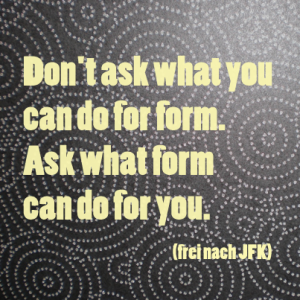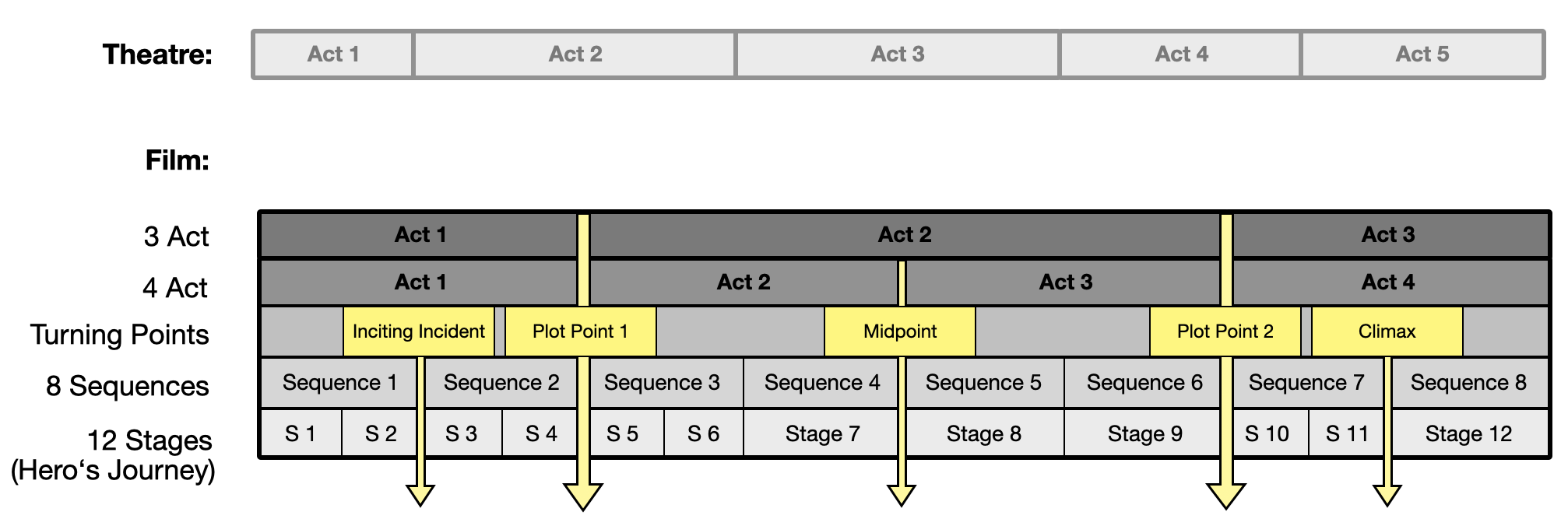Structure styles

The dramatic structure represents the framework or ‘meta-structure’ of the story beyond the specific plot.
All closed story structure styles are versions of the theatrical 5-act-structure drama. Since their basic structure is made up of three acts it is possible to integrate them into a universal design:
The 3-act-structure is the oldest basic form of the closed story structure. Since the second act is about twice as long as the first and third act it is often divided into two halves – 2a and 2b.
The only difference between 4-act and 3-act-structure is that the middle act is understood as two separate acts as it is about twice as long as the first and the last. This numbering can be confusing as the third act is usually understood as the final act of the film.
The (8-)sequence-structure enables a precise structuring; even complex stories are organized into clear units. This originates in the fact that films used to be made up of eight film rolls. To preserve the dramatic arc, rolls used to be changed after a sequence. Until the 1950s, most Hollywood screenplays were formatted with sequences explicitly identified.
The sequence model was developed by Frank (František) Daniel and authored by Paul Joseph Gulino in book form. Each sequence consists of 8 to 15 pages / minutes and ends with a turning point. By focusing on the dramatic aspects of each sequence, the challenges of the story as a whole can be mastered more easily. Chris Soth developed a related model with his “Mini-Movie Method”, which also consists of eight sequences (mini-movies).
The hero’s journey represents the unconscious story of the protagonist, his psychic developmental process: His journey first plunges the protagonist into an existential crisis and leads to his collapse. But the hero makes the breakthrough and finally emerges strengthened and matured from this experience: “growth through crisis” or “from breakdown to breakthrough” – so you can bring the hero’s journey to a short denominator.
The shape of the hero’s journey is a circular movement, starting in the ordinary (day) world. The journey leads the protagonist across the threshold down to the nightworld before returning to the dayworld. Often the hero’s journey is understood as a model of the plot structure, but in fact it is a model for the meta structure of a story. As such, it can support and inspire the creative process by allowing an in-depth reflection of the story. Dayworld and nightworld stand for opposing values.
For the first time, Joseph Campbell recognized the universal structures of the myths in “Hero with a Thousand Faces” and worked them out as a “hero’s journey” with a total of 17 stages of development. Christopher Vogler has discovered the hero’s journey for writers by seeing a universal structure in (film) narratives. In his standard work “The Writer’s Journey: Mythic Structure for Writers” he describes the hero’s journey as a monomyth with 12 stages of development.
Step-structures
A step model is a guideline for the development of a (film) story. Each step represents an element or stage of the story and fulfills a specific narrative function.
There are several step models developed primarily by US-American script master teachers. The number of steps varies according to each theory. Examples are the 22 Story Steps by John Truby, the 16 Story Steps by Keith Cunningham, the 15 Story Steps by John Vorhaus or the 8 Steps by Dan Harmon (“Story Cycle”). The 15 Beats by Blake Snyder (“Save the Cat”) also represent a comparable structural model.
 Further Reading
Further Reading
• Brody, Jessica: Save the Cat! Writes a Novel: The Last Book On Novel Writing You’ll Ever Need. 2018.
• Campbell, Joseph: Hero with a Thousand Faces. London 1993.
• Cunningham, Keith: Soul of Screenwriting: On Writing, Dramatic Truth, and Knowing Yourself. London/New York 2008.
• Gulino, Paul: Screenwriting: The Sequence Approach. The Hidden Structure of Successful Screenplays. 2004.
• Snyder, Blake: Save the Cat! 2005.
• Soth, Chris: Million-Dollar Screenwriting: The Mini-Movie Method. 2014.
• Truby, John: The Anatomy of Story: 22 Steps to Becoming a Master Storyteller. London 2008.
• Vogler, Christopher: The Writer’s Journey: Mythic Structure for Writers. California 1998.
• Vorhaus, John: The Comic Toolbox. Los Angeles 1994.



Comments are closed.